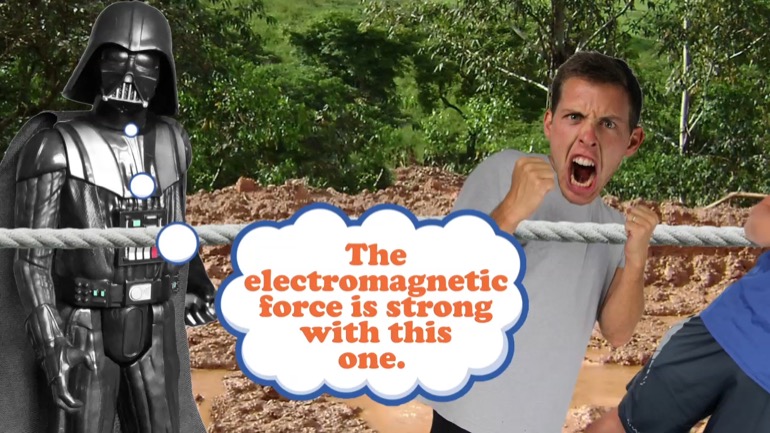ShmoopTube
Where Monty Python meets your 10th grade teacher.
Search Thousands of Shmoop Videos
Physics Videos 34 videos
Isaac Newton. Who was he? Why do we need to know about him? In a physics course, no less? Well, he's only the most famous physicist in history, and...
What are the basics of trigonometry? And why are we learning about this in a physics course? Both good questions. In this video, you'll learn about...
It's time to make our liters and meters work together. Enough of the bickering, right? In this video, we'll do some unit analysis, covering SI Unit...
Physics: Newton's First Law 962 Views
Share It!
Description:
Newton's first law is the one about objects at rest tending to stay at rest and objects in motion tend to stay in motion.
Transcript
- 00:02
Newton's first law or why we want to stay in bed. if I could find the right one...
- 00:08
a shapes motion - all right net forces -object grass motion -all [Newton's laws listed]
- 00:24
right unbalanced forces- isn't that
- 00:26
Congress ? people are all unbalanced? who would ever want that job?
- 00:32
anyway alright well Tiger pounds in constant motion, the real moral friction,
Full Transcript
- 00:36
really terminal velocity ,up now it's a great film Schwarzenegger. alright we're
- 00:41
done.
- 00:43
hey have you ever run out of gas? just been driving along belting out Taylor
- 00:49
Swift at the top of your lungs when all of a sudden your car dies? look at the [car going down the road]
- 00:53
fuel gauge see that the needle is way on the wrong side of e, maybe you're lucky
- 00:57
and there's a gas station a few blocks away and maybe you're unlucky because
- 01:00
you inherited grandma's 1974 El Camino, yeah that thing's like an aircraft
- 01:06
carrier, but wait why'd the stupid car even stop in the first place?
- 01:09
well doesn't an object in motion tend to stay in motion? why did it stop? we're on
- 01:14
a perfectly flat stretch of road what force acted against it? all goes back [road shown]
- 01:18
to Newton's first law of motion. remember Sir Isaac Newton crazy smart British guy
- 01:23
lived in the 1600s. not the best at interpersonal relations? old Ike here
- 01:29
discovered three laws of motion and a lot of physics is built on those three
- 01:33
laws. we'll be taking a deep dive into each of those laws in future sessions
- 01:37
but today we're gonna be looking at numero uno. Newton's first law of motion
- 01:41
is that you do not talk about motion. sorry that was Newton's first law of [chalk board with newton's laws]
- 01:46
Fight Club. his first law of motion is that an object's motion or lack of
- 01:51
motion will stay constant unless a force acts against it. so in order for an
- 01:57
object's motion to be constant that means no force can be acting on it there
- 02:02
right ?you no see there's this thing called net
- 02:05
force, and no it's not the next hit drama on CBS this fall. net force means that
- 02:13
combined sum of all forces acting on an object and if the net force is acting on
- 02:18
an object balance each other out, well the motion will be constant. so let's
- 02:22
take a look at the net forces acting on one specific object. and that object is
- 02:25
yep your butt. don't worry we're not gonna go look at the physics of shaking [boy falls down]
- 02:30
your moneymaker. for that you can explore schmoops special course on twerking. but
- 02:35
chances are that you're sitting down right now and you may not think that
- 02:38
sitting on your tail has anything to do with physics, but Oh your chair says
- 02:42
otherwise. right now as you sit there gravity is exerting a force on your body
- 02:46
it's trying to pull you toward the center of the earth but your chair is [man sits in a chair]
- 02:50
holding you up exerting a force perpendicular to its surface. that force
- 02:55
is called the normal force. when force is applied to a solid object that object's
- 03:00
shape changes. it might deform a little or it might deform a lot. even if the chair
- 03:06
is made of solid granite and a cute little mouse is sleeping on it, there's
- 03:10
still a tiny amount of deformation because a force even a tiny one is being [mouse sits on rock chair]
- 03:15
applied to the chair .now if that force isn't balanced by a counter force
- 03:19
shedder the mouse here would just, well sink into the chair. solid objects
- 03:24
maintain their shape which is what makes them, you know solid. so they act against
- 03:28
the deformation by pushing against whatever is causing that deformation. now
- 03:34
if a brontosaurus tried to sit in that chair the chair may not be able to
- 03:37
maintain it's shape. the force of gravity acting on the dinosaur might overcome
- 03:41
the normal force of the chair which is why you'll never see a depiction of a
- 03:46
brontosaurus taking a load off in a Natural History Museum. so in the case of [dinosaur in museum]
- 03:50
you sitting on a chair the net force equals zero. the downward force of
- 03:54
gravity is balanced by the upward normal force of the chair. well here on earth
- 03:59
that's the case for any object that's not moving. but what about an object that
- 04:03
is actually in motion and has a constant velocity? well suppose a car has
- 04:07
cruise control. you're on the highway and you press a button and your car
- 04:11
maintains a steady speed, and you take a nap. don't actually do that last part. as [navigation system shown]
- 04:16
we've learned the hard way your car can't just cruise without exerting force
- 04:19
in burning gasoline, but if the motion is constant, well why is any force needed to
- 04:25
maintain speed? well it's time to talk about the F word, and no no the other
- 04:30
f word. we're talking about friction friction is a force exerted by one
- 04:35
object on another object when the two objects slide across each other. [friction defined]
- 04:41
in some of our previous lessons we looked at imaginary scenarios in a world
- 04:45
where we could pretend friction doesn't exist .but as we've learned from when we
- 04:49
slide past the end of the slip and slide friction does exist. and it can sometimes
- 04:54
be painful. there's no escaping friction at least not here on earth. think you can [girl grimaces after getting scrapes]
- 04:58
roll yourself away from friction? nope a car can tell you that's not true. even an
- 05:04
airplane flying way up in the atmosphere still encounters drag ,which is friction
- 05:09
from the air. only in outer space can you truly have a frictionless experience the
- 05:14
United States launched the Voyager spacecraft in 1977 to study planets in
- 05:18
our solar system. and it's still traveling through space today. [satellite shown]
- 05:21
unless aliens have grabbed it and eaten it or something.
- 05:25
in fact it's traveled outside of our solar system it's still moving because
- 05:30
while there are no forces stopping it. not even friction. if we're stuck on the
- 05:34
planet though there's no getting around the gravity thing. sure we can reduce
- 05:37
friction by making surface as smooth as possible, and we add slippery stuff to
- 05:42
reduce friction - yeah just go wash your hands to feel how soap reduces friction. [woman grins in a bathroom]
- 05:47
or do seriously go watch out where those paws of yours have been?
- 05:51
reducing friction is also why you get oil changes for your car. motor oil
- 05:57
reduces friction in the engine which makes it work more efficiently, but we
- 06:01
measure the friction between two objects with the coefficient of friction. if
- 06:06
you're pulling a German Shepard toward the bathtub you've got a high
- 06:08
coefficient of friction .if you're dragging a hot knife across the stick of [boy drags dog]
- 06:13
warm butter you've got a low coefficient of friction. and the markings for a
- 06:17
lovely piece of toast. we'll get more into this coefficient thing in future
- 06:20
lessons but if we're using cruise control on our car that means the engine
- 06:24
is producing enough force to balance out the force of friction. so we move at a
- 06:29
constant speed until some moron in the fast lane decides to start exiting, and
- 06:34
if we have to hit the brakes so we don't get killed. [woman drives race car]
- 06:36
well friction creates heat energy which you know if you've ever rub your hands
- 06:41
together to keep warm and that heat from friction is why cavemen didn't have to
- 06:45
eat mammoth sashimi. as we've said friction is a force that
- 06:48
acts in the opposite direction of movement. we can see that in this diagram
- 06:51
right here. all right well to achieve constant [chart shown]
- 06:54
unchanging motion we have to apply force in the direction of motion that's equal
- 06:58
to the counter force of friction. like cruise control -for like a plane flying
- 07:03
in the sky so high. think of how many counter balancing forces a 747 flying at
- 07:08
a steady speed has to deal with. well it's got its jet engines providing
- 07:12
enough force in the forward direction and balance the friction acting on it in
- 07:15
the backwards direction. when those net forces add up to zero the plane will be
- 07:20
at a cruising speed and the pilot can finish his you know word search or [men fly airplane]
- 07:24
whatever. but gravity is still involved too so there has to be enough lift to
- 07:28
balance that force out as well otherwise the plane would you know do the opposite
- 07:33
of lift. but while we're thinking about a large object plummeting to the ground
- 07:37
let's talk about terminal velocity. not starring Arnold Schwarzenegger.
- 07:41
next time you go skydiving try switching out your parachute for your spare tire.
- 07:46
then jump out of an airplane and see if your trip down is in a bit more exciting [animation parachutes]
- 07:51
than it would be with a boring old parachute .when we're traveling through
- 07:55
the atmosphere we counter drag well drag is a specific
- 07:58
kind of friction that occurs when an object is moving through a fluid and gas
- 08:02
air counts as a fluid in this case. the amount of drag on an object depends on a
- 08:07
few different factors like the density of the fluid ,and the shape of the object.
- 08:12
and the speed of an object affects the drag as well. the faster it's moving the [jam sandwich shown]
- 08:18
greater the drag. now in some previous lessons we looked at falling objects and
- 08:22
said that gravity would provide a constant acceleration of 9.8 meters per
- 08:25
second squared .but that's not actually the case when you're dealing with drag,
- 08:30
so let's go back to skydiving. like I said the faster we move through the air
- 08:33
the more drag acts on us. well eventually we'll reach a point
- 08:37
where the force of gravity and the force of drag balance each other out, and we'll
- 08:43
stop accelerating, and just followed a nice easy rate of about 200 kilometers
- 08:48
an hour. well the point we stopped accelerating is called terminal velocity
- 08:53
or the end of velocity. and yeah if we don't open our chutes soon it'll [galaxy shown]
- 08:57
definitely be terminal. well terminal velocity is the highest velocity an
- 09:01
object can reach in a fall. well when we do open our parachute the terminal
- 09:06
velocity will drop all the way down to 28 kilometers an hour .the size shape and
- 09:10
mass of the parachute create much more drag in the air and that force acts in
- 09:15
counter to the force of gravity slowing us down and letting, us you know live.
- 09:19
well using a spare tire instead of a parachute? well let's just say that [animation using a parachute]
- 09:22
falling ...falling that way would be a drag. because well there wouldn't be very much
- 09:27
drag. so in order to get this rust-bucket moving we have to apply enough force to
- 09:31
overcome its inertia. Newton's first law is sometimes referred to as the law of
- 09:35
inertia. and inertia is a property of mass. specifically inertial mass is the
- 09:41
measure of an object's resistance to acceleration or resistance to a change
- 09:46
in motion. the more mass something has the more resistance it has to have to [car goes down the road]
- 09:51
its motion being changed. which makes sense it's easier to pull a
- 09:55
shopping cart than it is to push a 1974 El Camino because the car has a whole
- 10:01
lot more mass than the shopping cart. and we're gonna have to put the concept of
- 10:04
inertia to the tester is going to push the car to the gas station, but we may
- 10:09
not be able to overcome its resistance to being moved. maybe we can just leave
- 10:13
it here. it's a about time and get a new car anyway. of course getting a new car
- 10:17
would involve overcoming dads and neural resistance to open his wallet book. [animation in office] -
- 10:21
that's a different set of laws.
Related Videos
When you're about to marry the love of your life, not many things could stop you. However, finding out that your future hubby is keeping his crazy...
Here at Shmoop, we work for kids, not just the bottom line. Founded by David Siminoff and his wife Ellen Siminoff, Shmoop was originally conceived...
ACT Math: Elementary Algebra Drill 4, Problem 5. What is the solution to the problem shown?
AP® English Literature and Composition Passage Drill 1, Problem 1. Which literary device is used in lines 31 to 37?
AP® English Literature and Composition Passage Drill 2, Problem 1. What claim does Bacon make that contradicts the maxim "Whatsoever is delig...






































